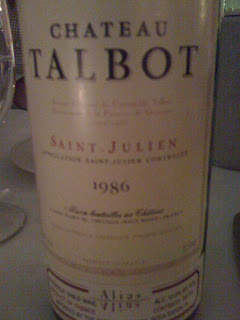 2004 Domaine Belland Criots-Batard-Montrachet
2004 Domaine Belland Criots-Batard-Montrachet -Tight and young, the nose had a slight almond and pear aroma. Pineapple and butter on the rich palate. The fruit is there, but it is hiding. I believe this will be a great wine once it comes in to its own. Cellar Note: Hold for at least 2 years, should drink well 2-7 years.

2002 Domaine Hudelot-Baillet Chambolle-Musigny Les Charmes
*** Cork Dork Alert ***
I will give everyone fair notice when I am about to venture into the area of too much information.
Today’s topic: Bottle Variation
How is it that two bottles of wine from the same case can taste vastly different? Many reasons which stem from the fact that wine is a living evolving substance that include, but are not limited to:
The Cork
• If it is a natural cork, the seal and density may vary allowing different amounts of oxygen to seep through. This will cause two bottles stored under the same conditions to taste different.
• It may contain the defect TCA (2,4,6-Tribromoanisole) a fungus that gives wine a wet paper bag smell and robs the wine of fruit flavors.
The Bottle
• Residue from cleaning fluids may be left.
• Live yeast in the bottle can cause a second fermentation to occur in the bottle causing the wine to be fizzy.
• Barrel Variation. One bottle could be filled from a different barrel than another.
And finally what I experienced Sunday. The first bottle we opened had a pronounced earthy barnyard scent that was mixed with scents of dark cherry which you would expect from a world class Pinot Noir. The barnyard was there when the wine was tasted, but the dark cherry and red licorice also showed through. My guess is the presence of Brettanomyces or Brett., a yeast that will produce that barnyard effect. The yeast can live in the barrels or in the winery. Some winemakers like Brett. in small amounts. They feel it gives the wine an added layer of complexity.
The second bottle we opened was gorgeous with all the fruit flavors I mentioned, but with a clean nose and taste. This was a truly great bottle of wine. If it was Brett, it is possible that we tasted wines from two different barrels, one with a greater prevalence of Brett. than the other.
Here is the dilemma. The presence of the listed defects can vary. If it is blatant the bottle can be returned to the shop or sent back at a restaurant. In this case, if we did not have the second bottle, I would assume that it was characteristic of the wine. Even tasting the great second bottle do you spend the money on an $80 bottle of wine and take the risk? On the other side when you are dealing with small producers that are not overly filtering their wines and making profoundly great wines you get blemishes. What do you think?
 2003 Thierry Beaumont Morey Saint Denis Les Sorbes
2003 Thierry Beaumont Morey Saint Denis Les Sorbes – A big ripe generous Pinot showing the heat of the vintage. Plum fills the nose; flavors of chocolate covered cherries abound in the rich palate. Not your traditional elegant Burgundy. Cellar Note: Enjoy over the next 5-10 years while your classic 2002’s mature.















